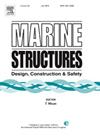地震和环境荷载作用下带冲刷护套基础的水轮机动力响应
IF 5.1
2区 工程技术
Q1 ENGINEERING, CIVIL
引用次数: 0
摘要
四足桩夹套(TPJ)基础已广泛应用于海上风力发电机组。然而,在环境荷载和波浪流冲刷现象的影响下,TPJ支撑OWT体系的地震响应研究还存在明显的不足。在这些地震多发地区,tpj支撑的OWT在使用寿命期间可能会遇到过大的倾覆变形和动力响应。为填补现行TPJ基础抗震设计规范的空白,综合考虑冲刷深度、土体强度、地震频率含量和烈度等潜在影响因素,综合分析了TPJ体系在冲刷场地随机环境荷载作用下的地震响应。研究发现,TPJ系统的高刚度钢框架具有较强的承受侧向加速度和变形的能力。冲刷深度的发展改变了TPJ结构的破坏位置和桩土相互作用机制,导致加速度和弯矩响应扩大,桩基有抬升趋势。虽然较高的土强度提高了TPJ体系对垂直和水平变形的抵抗能力,但也放大了TPJ体系的加速度和弯矩响应。值得注意的是,与迎风桩相比,背风桩的弯矩更大,需要在设计中采取额外的保护措施。这些发现为研究tpj支撑的wt在复杂的地震环境中的地震响应提供了有价值的见解。本文章由计算机程序翻译,如有差异,请以英文原文为准。
Dynamic response of OWTs with scoured jacket foundation subjected to seismic and environmental loads
Tetrapod piled jacket (TPJ) foundations have been widely employed to support offshore wind turbines (OWTs). However, under the influence of environmental loads and wave-current-induced scouring phenomenon, there remains a notable research deficiency concerning the seismic response of TPJ supported OWT system. In these earthquake-prone areas, TPJ-supported OWT may encounter excessive overturning deformations and dynamic responses during its service life. To fill the gap in the current seismic design codes for TPJ foundations, this study comprehensively analyzed the seismic response of the TPJ system subjected to stochastic environmental loads at scoured sites, considering several potential influencing factors, such as the scour depth, soil strength, seismic frequency content and intensity. It is found that the high-stiffness steel framework of the TPJ system demonstrates a robust ability to withstand the lateral responses of acceleration and deformation. The development of scour depth alters the failure location of the TPJ structure and the pile-soil interaction mechanism, leading to an expansion in the acceleration and bending moment response, and an uplift trend in the pile foundation. Although higher soil strength improves the resistance of the TPJ system to vertical and horizontal deformations, it also amplifies the acceleration and bending moment responses of the TPJ system. Notably, the bending moments are greater in the leeward piles compared to the windward piles, necessitating additional protective measures in the design. These findings offer valuable insights into the seismic response of TPJ-supported OWTs in complex paralic environments.
求助全文
通过发布文献求助,成功后即可免费获取论文全文。
去求助
来源期刊

Marine Structures
工程技术-工程:海洋
CiteScore
8.70
自引率
7.70%
发文量
157
审稿时长
6.4 months
期刊介绍:
This journal aims to provide a medium for presentation and discussion of the latest developments in research, design, fabrication and in-service experience relating to marine structures, i.e., all structures of steel, concrete, light alloy or composite construction having an interface with the sea, including ships, fixed and mobile offshore platforms, submarine and submersibles, pipelines, subsea systems for shallow and deep ocean operations and coastal structures such as piers.
 求助内容:
求助内容: 应助结果提醒方式:
应助结果提醒方式:


